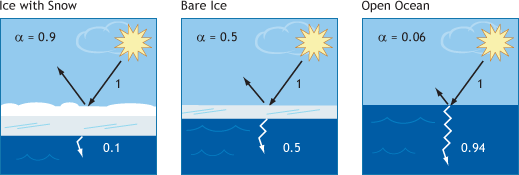Introduction
Which would keep you cooler in summer, a white shirt or a dark shirt? Consider this: light-colored objects reflect more solar energy (i.e., heat), and stay cooler as a result. In contrast, dark-colored objects absorb more solar energy, becoming warmer.
When light from the Sun strikes Earth's surface, some of the energy is absorbed as heat and some is
reflected back into space. The darker the object, the more radiation is absorbed. The fraction of radiation that is reflected back into space is known as albedo. These diagrams illustrate how albedo (α) is higher over ice and snow than over bare ice or open ocean.
How do you think the melting of sea ice and snow would affect the amount of energy reflected or absorbed?

Credit: The National Snow and Ice Data Center